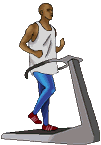|
The best way to treat low back pain is to prevent it.
But as we all know, hindsight is 20/20. To really develop a healthy
back, what is needed is not a fancy home gym (although that is always nice),
but determination, motivation, a little bit of time each day, and a
schedule. Let's face it, it's never "convenient" for any of us to set
aside time to exercise and do the necessary things for
weight loss, but if we get into a routine, we start to depend
upon it. Our day is not complete until we do it. Many clients
and patients, who initially were among the most unlikely of dedicated
athletes, have been known to actually be in a bad mood if someone or
something interrupted their workout. Their day wasn't complete unless
they finished their exercise. Does this sound familiar? If not,
stay with us, and ask yourself this question in the future.
 Exercise makes us feel better for many reasons.
It increases blood flow to our heart and muscles, taking away lactic acid
and other breakdown products more efficiently. It also delivers more
oxygen and nutrients to the damaged muscle. It strengthens the "guy
wires" also known as muscles, tendons, and ligaments, which hold our bones,
and in particular, our spines, together. This reduced stress on the
bones and joints. It promotes the release of endorphins, which act as
narcotics upon the brain. It also makes us look better, and the
compliments which people pay us can only improve our attitudes. Exercise makes us feel better for many reasons.
It increases blood flow to our heart and muscles, taking away lactic acid
and other breakdown products more efficiently. It also delivers more
oxygen and nutrients to the damaged muscle. It strengthens the "guy
wires" also known as muscles, tendons, and ligaments, which hold our bones,
and in particular, our spines, together. This reduced stress on the
bones and joints. It promotes the release of endorphins, which act as
narcotics upon the brain. It also makes us look better, and the
compliments which people pay us can only improve our attitudes.
Key to exercise are cardiovascular activities, as well
as strength training. Prior to any exercise, it is important to
undergo a warm up session and a stretching session.
Consult your physician before beginning any
exercise program. If pain develops, stop immediately and notify your
physician.
Warm up and Stretching
A warm up can consist of five minutes on the
treadmill, at a brisk walk pace, or five minutes on the stationary bike.
It is not necessary to break a sweat, but rather to get the muscles warm and
heart rate at about one hundred. Follow the warm up with stretching.
The stretching is important. In a slow yet deliberate manner, stretch
the back, chest, shoulders, arms and legs. Stretching can easily be
done by yourself, and resistance can be provided by a wall or doorway, to
stretch groups such as the pectorals, biceps and triceps. Many gyms
have a chair designed to provide an optimum stretch. Another favorite
for the pectorals is to stand, with the arms extended backward, while a
partner slowly pushes them together behind your back. The arms should
be help on mild tension for twenty seconds. Try it. You will
agree that this is an incredible stretch on the pectorals.
Cardiovascular Activity
For cardiovascular activity, the goal is duration, not
intensity. It is much better to walk briskly for twenty to thirty
minutes, than to sprint for five minutes. DURATION FIRST, SPEED WILL
FOLLOW!! While a person in good shape may target an exercise
heart rate of 85 percent of their maximum, a person in lesser shape might
target 60 percent.
Although a number of methods are available to calculate maximum heart
rate, most are cumbersome, and the only accurate method is a stress test.
A practical method is as follows:
Men: 220 minus your age (add 10 points if you
are already fit)
Women: 226 minus your age (add 10 points if you
are fit)
Guide workouts according to your level (consult a
physician before starting a workout program):
Beginner (over 30 years age, overweight,
sedentary for 10 years): it will take you 6 months to get your body
conditioned to run; don't go above 70% of maximum heart rate;
Intermediate: generally 80 to 85% of maximum
heart rate, with short interval bursts of exercise at up to 90% of maximum
heart rate;
To measure pulse, use the wrist
measurement, not the carotid artery in the neck. Pressure on the
carotid artery may cause a vagal response, which may slow the rate by 10
beats per minute.
In choosing a cardiovascular activity, running or
walking is better for those with low back pain and herniated disks, than is
riding a stationary bike. The sitting position puts stress on the low
back, and may exacerbate low back pain.
COOL DOWN after each cardiovascular session. Do
so until the pulse is below 100.
next
|

